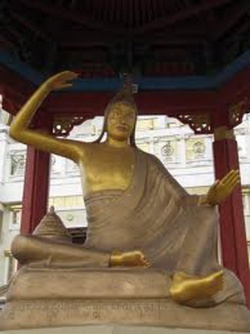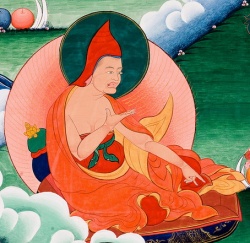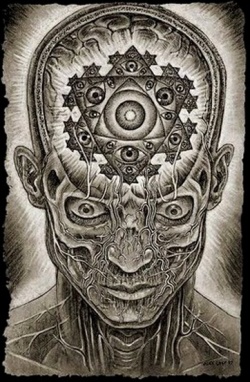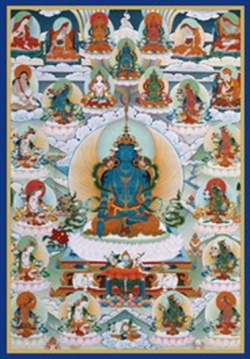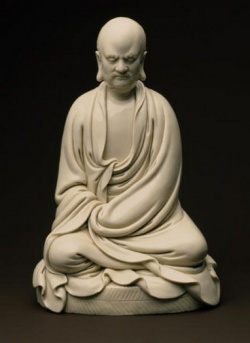Difference between revisions of "Dignaga's Logic of Invention"
| Line 3: | Line 3: | ||
Original Source: http://www.indology.net/article16.html | Original Source: http://www.indology.net/article16.html | ||
[[File:Acharya-dignaga.jpg|thumb|250px|]] | [[File:Acharya-dignaga.jpg|thumb|250px|]] | ||
| − | by Volker Peckhaus | + | by [[Volker Peckhaus]] |
| − | Universitaet Paderborn Fakultaet | + | Universitaet Paderborn Fakultaet fuer Kulturwissenschaften - Philosophie Warburger Str. 100, D - 33098 Paderborn |
| − | fuer Kulturwissenschaften - Philosophie | ||
| − | Warburger Str. 100, D - 33098 Paderborn | ||
E-mail: peckhaus@hrz.upb.de | E-mail: peckhaus@hrz.upb.de | ||
[[File:Dignaga-44d.jpg|thumb|250px|]] | [[File:Dignaga-44d.jpg|thumb|250px|]] | ||
| Line 17: | Line 15: | ||
"What is the role of [[logic]] in [[philosophy]] of [[science]], especially in a [[philosophy]] of [[science]] which takes the context of discovery into account?" | "What is the role of [[logic]] in [[philosophy]] of [[science]], especially in a [[philosophy]] of [[science]] which takes the context of discovery into account?" | ||
[[File:Dignaga15w.jpg|thumb|250px|]] | [[File:Dignaga15w.jpg|thumb|250px|]] | ||
| − | In {{Wiki|Europe}} the sensitivity for the great efforts of {{Wiki|Indian logic}} is mainly due to J. M. Bochenski's [[appreciation]] for it as expressed, e. g., in his Formale Logik of 1956. [[Bochenski]] regarded [[Dignaga]], who lived from about 480 to 540 A. D., as the [[Indian]] {{Wiki|Aristotle}}. | + | In {{Wiki|Europe}} the sensitivity for the great efforts of {{Wiki|Indian logic}} is mainly due to [[J. M. Bochenski's]] [[appreciation]] for it as expressed, e. g., in his Formale Logik of 1956. [[Bochenski]] regarded [[Dignaga]], who lived from about 480 to 540 A. D., as the [[Indian]] {{Wiki|Aristotle}}. |
For [[Bochenski]] the [[Indian]] [[experience]] was even one of the cornerstones for his reflections on a {{Wiki|general}} {{Wiki|theory}} of the historical [[development]] of [[logic]]. | For [[Bochenski]] the [[Indian]] [[experience]] was even one of the cornerstones for his reflections on a {{Wiki|general}} {{Wiki|theory}} of the historical [[development]] of [[logic]]. | ||
| Line 23: | Line 21: | ||
The [[development]] of [[logic]] was in fact not a continuous one starting with {{Wiki|Aristotle}} and ending with {{Wiki|modern}} {{Wiki|mathematical}} [[logic]], but a series of ups and downs, full of [[unconscious]] re-inventions, and it started from a double [[root]], the {{Wiki|ancient Greek}} and the {{Wiki|ancient}} or {{Wiki|medieval}} {{Wiki|Indian logic}}. | The [[development]] of [[logic]] was in fact not a continuous one starting with {{Wiki|Aristotle}} and ending with {{Wiki|modern}} {{Wiki|mathematical}} [[logic]], but a series of ups and downs, full of [[unconscious]] re-inventions, and it started from a double [[root]], the {{Wiki|ancient Greek}} and the {{Wiki|ancient}} or {{Wiki|medieval}} {{Wiki|Indian logic}}. | ||
[[File:Dignaga335.jpg|thumb|250px|]] | [[File:Dignaga335.jpg|thumb|250px|]] | ||
| − | It might be worthwhile to sum up Bochenski's results, despite the fact that most of his positions have been disputed in the last 45 years of research. [[Bochenski]] devoted the sixth (and final) part of his Formale Logik to the "[[Indian]] Variety of [[Logic]]". | + | It might be worthwhile to sum up [[Bochenski's]] results, despite the fact that most of his positions have been disputed in the last 45 years of research. [[Bochenski]] devoted the sixth (and final) part of his Formale Logik to the "[[Indian]] Variety of [[Logic]]". |
[[File:Skandhas 01.jpg|thumb|250px|]] | [[File:Skandhas 01.jpg|thumb|250px|]] | ||
1. He stressed that [[logic]] arose in two {{Wiki|distinct}} {{Wiki|cultural}} areas, in the Occident and in [[India]], and the [[Indian]] [[Buddhist logician]] | 1. He stressed that [[logic]] arose in two {{Wiki|distinct}} {{Wiki|cultural}} areas, in the Occident and in [[India]], and the [[Indian]] [[Buddhist logician]] | ||
| Line 52: | Line 50: | ||
In the following I will be concerned only with the [[first]] two steps. In his final {{Wiki|evaluation}} [[Bochenski]] said that [[Dignaga's]] {{Wiki|syllogistic}} was still completely determined by examples. [[Dignaga]] was not [[able]] to entirely free himself from the pressure of the {{Wiki|methodological}} [[tradition]] (506). | In the following I will be concerned only with the [[first]] two steps. In his final {{Wiki|evaluation}} [[Bochenski]] said that [[Dignaga's]] {{Wiki|syllogistic}} was still completely determined by examples. [[Dignaga]] was not [[able]] to entirely free himself from the pressure of the {{Wiki|methodological}} [[tradition]] (506). | ||
| − | This criti- cism is a clear indicator of Bochenski's one-sided preference for formal [[logic]]. | + | This criti- cism is a clear indicator of [[Bochenski's]] one-sided preference for formal [[logic]]. |
At several places he polemically depreciated all non-formal [[directions]] of log- ical {{Wiki|theory}}. | At several places he polemically depreciated all non-formal [[directions]] of log- ical {{Wiki|theory}}. | ||
| − | This is also the [[reason]] for Bochenski's isolated [[interest]] in formal aspects of the [[hetucakra]]. | + | This is also the [[reason]] for [[Bochenski's]] isolated [[interest]] in formal aspects of the [[hetucakra]]. |
He, like later commentators, pointed at the differ- ences between the [[Indian]] and the {{Wiki|Greek}} [[forms]] of formal [[logic]]. {{Wiki|Indian logic}}, he said, had no [[knowledge]] of variables, and furthermore a pronounced in- tensional tendency (516-517). | He, like later commentators, pointed at the differ- ences between the [[Indian]] and the {{Wiki|Greek}} [[forms]] of formal [[logic]]. {{Wiki|Indian logic}}, he said, had no [[knowledge]] of variables, and furthermore a pronounced in- tensional tendency (516-517). | ||
| Line 88: | Line 86: | ||
| − | Text of [[Dignaga's]] Hetucakranirnaya, known in [[Tibetan]] as [[gtan tshigs]] kyi hkhor lo [[gtan la dbab pa]] Obeisance to [[Manjusrikumarabhuta]] | + | Text of [[Dignaga's]] [[Hetucakranirnaya]], known in [[Tibetan]] as [[gtan tshigs]] kyi hkhor lo [[gtan la dbab pa]]]] Obeisance to [[Manjusrikumarabhuta]] |
1. After obeisance to the [[Omniscient]] ([[Buddha]]) who is the destroyer of the snares of [[ignorance]], the [[determination]] of [[hetu]] with three-fold [[characteristic]] is pointed out. | 1. After obeisance to the [[Omniscient]] ([[Buddha]]) who is the destroyer of the snares of [[ignorance]], the [[determination]] of [[hetu]] with three-fold [[characteristic]] is pointed out. | ||
| − | 2-4a-b. There will be the presence, the absence as well as both the | + | 2-4a-b. There will be the presence, the absence as well as both the presence and the absence (i. e. presence in some part, while absence in another) of the [[hetu]] in the [[anumeya]] (that which is to be proved [[probandum]]). |
| − | If there be the presence of [[hetu]], the | + | If there be the presence of [[hetu]], the conclusion will be correct, while the absence thereof will make it invalid. |
If there be both the presence and the absence (of the [[hetu]] in the [[anumeya]]) the conclusion will be [[doubtful]] just like an invalid one. | If there be both the presence and the absence (of the [[hetu]] in the [[anumeya]]) the conclusion will be [[doubtful]] just like an invalid one. | ||
| − | 3c-d-4a-b. There will be the presence, the absence as well as both (of the [[hetu]] in the sapaks.a (that which is analogous to the paks.a - | + | 3c-d-4a-b. There will be the presence, the absence as well as both (of the [[hetu]] in the sapaks.a (that which is analogous to the paks.a-anumeya]] or the [[object]] of [[inference]]). |
| − | And similarly in the vipaks.a (that which is opposed to the paks.a) there will be the presence, the absence, as well as both the presence and the absence of the [[hetu]]. So there will be [[three classes]] of the threefold [[hetu]] (i. e. nine varieties in all). | + | And similarly in the vipaks.a (that which is opposed to the [[paks.a]]) there will be the presence, the absence, as well as both the presence and the absence of the [[hetu]]. So there will be [[three classes]] of the threefold [[hetu]] (i. e. nine varieties in all). |
| − | 4c-d-5a-b. The [[hetus]] at the top and the bottom (in the middle of the het- ucakra or the table of [[hetus]] i. e. nos. 2 and 8) are valid, while those on the two sides (in the middle of the [[hetucakra]], i. e, nos. | + | 4c-d-5a-b. The [[hetus]] at the top and the bottom (in the middle of the [[het-ucakra]] or the table of [[hetus]] i. e. nos. 2 and 8) are valid, while those on the two sides (in the middle of the [[hetucakra]], i. e, nos. |
4 and 6) are [[contradictory]]. | 4 and 6) are [[contradictory]]. | ||
| Line 113: | Line 111: | ||
(1) [[prameya]] (knowable), | (1) [[prameya]] (knowable), | ||
| − | (2) kr.taka (effected), | + | (2) [[kr.taka]] (effected), |
(3) [[anitya]] (non- [[eternal]]), | (3) [[anitya]] (non- [[eternal]]), | ||
| − | (4) krta (effected), | + | (4) [[krta]] (effected), |
5) [[sravana]] (audible), | 5) [[sravana]] (audible), | ||
| − | (6) yatnaja (made by efforts), | + | (6) [[yatnaja]] (made by efforts), |
(7) [[anitya]] (non-eternal), | (7) [[anitya]] (non-eternal), | ||
| − | (8) yatnaja (made by efforts), | + | (8) [[yatnaja]] (made by efforts), |
| − | (9) amurta (incorporeal). | + | (9) [[amurta]] (incorporeal). |
| Line 153: | Line 151: | ||
| − | These (nine) beginning with the [[nitya]] are put (in the [[cakra]] as sadhyas) those that are to be proved. | + | These (nine) beginning with the [[nitya]] are put (in the [[cakra]] as [[sadhyas]]) those that are to be proved. |
7b-8a. There are two valid [[hetus]] in the middle at the top and the bottom (i. e. in nos. 2 and 8 of the [[cakra]]), and two [[contradictory]] [[hetus]] in the middle at the top and the bottom (i. e. in nos. 4 and 6 of the [[cakra]]). | 7b-8a. There are two valid [[hetus]] in the middle at the top and the bottom (i. e. in nos. 2 and 8 of the [[cakra]]), and two [[contradictory]] [[hetus]] in the middle at the top and the bottom (i. e. in nos. 4 and 6 of the [[cakra]]). | ||
| − | 8b-9a. There are four uncertain ([[anaikantika]]) [[hetus]] in the four corners (i. e. in nos. 1, 3, 7 and 9 of the [[cakra]]). And the [[hetu]] is uncertain and uncommon ( | + | 8b-9a. There are four uncertain ([[anaikantika]]) [[hetus]] in the four corners (i. e. in nos. 1, 3, 7 and 9 of the [[cakra]]). And the [[hetu]] is uncertain and uncommon ([[anaikanta asadharana]]) in the centre (i. e. in no. 5 of the [[cakra]]) obtained by the cross connection of the four corners. |
| − | 9b-c. The table of nine [[hetus]] is what has been now described. 9d-11a. (The dr.s.t.antas or examples in the table are as follows): | + | 9b-c. The table of nine [[hetus]] is what has been now described. 9d-11a. (The [[dr.s.t.antas]] or examples in the table are as follows): |
| − | (1) nabhaghat.avat (like the [[space]] and the pitcher), | + | (1) [[nabhaghat.avat]] (like the [[space]] and the pitcher), |
| − | (2) ghatakasavat (like the pitcher and the [[space]]), | + | (2) [[ghatakasavat]] (like the pitcher and the [[space]]), |
| − | (3) ghatavidyudviyadvat (like the pitcher, the {{Wiki|lightning}} and the [[space]]), | + | (3) [[ghatavidyudviyadvat]] (like the pitcher, the {{Wiki|lightning}} and the [[space]]), |
| − | (4) viyadghat.avat (like the [[space]] and the pitcher), | + | (4) [[viyadghat.avat]] (like the [[space]] and the pitcher), |
| − | (5) | + | (5) [[akasaghatava]]t (like the [[space]] and the pitcher), |
| − | (6) viyadghatatadidvat (like the [[space]], the pitcher and the {{Wiki|lightning}}), | + | (6) [[viyadghatatadidvat]] (like the [[space]], the pitcher and the {{Wiki|lightning}}), |
| − | (7) vidyudakasaghatavat (like the {{Wiki|lightning}}, the [[space]] and the pitcher), | + | (7) [[vidyudakasaghatavat]] (like the {{Wiki|lightning}}, the [[space]] and the pitcher), |
| − | (8) ghatavidyudviyadvat (like the pitcher, the {{Wiki|lightning}} and [[space]]), | + | (8) [[ghatavidyudviyadvat]] (like the pitcher, the {{Wiki|lightning}} and [[space]]), |
| − | (9) akasanukarmavat (like the [[space]], {{Wiki|atom}} and [[action]]). | + | (9) [[akasanukarmavat]] (like the [[space]], {{Wiki|atom}} and [[action]]). |
| Line 187: | Line 185: | ||
All the examples are dealing with [[sound]]. Let me give you only two of them (cf. [[Bharadwaja]] 1990, 19): | All the examples are dealing with [[sound]]. Let me give you only two of them (cf. [[Bharadwaja]] 1990, 19): | ||
| + | |||
| + | |||
1. (a) [[Sound]] is [[eternal]] | 1. (a) [[Sound]] is [[eternal]] | ||
| + | |||
(b) because it is knowable like the [[space]] and the pitcher. | (b) because it is knowable like the [[space]] and the pitcher. | ||
| + | |||
Given the [[hetucakra]], this example represents a case of the [[constellation]] in corner 1. It is not acceptable because the [[reason]] is common, i. e., so {{Wiki|general}} that it would equally support the contrary of the {{Wiki|thesis}}, namely "[[sound]] is non-eternal". | Given the [[hetucakra]], this example represents a case of the [[constellation]] in corner 1. It is not acceptable because the [[reason]] is common, i. e., so {{Wiki|general}} that it would equally support the contrary of the {{Wiki|thesis}}, namely "[[sound]] is non-eternal". | ||
| + | |||
The second argument runs: | The second argument runs: | ||
| + | |||
2. (a) [[Sound]] is non-eternal | 2. (a) [[Sound]] is non-eternal | ||
(b) because it is produced like a pitcher and the [[space]]. | (b) because it is produced like a pitcher and the [[space]]. | ||
| + | |||
| + | |||
This argument is a good argument. It represents the case on top of the [[hetucakra]]. | This argument is a good argument. It represents the case on top of the [[hetucakra]]. | ||
| + | |||
| + | |||
Already from these few examples it is clear that the [[hetucakra]] serves as a method to determine the [[conditions]] a [[reason]] has to follow to be a good [[reason]] for a given {{Wiki|thesis}}. | Already from these few examples it is clear that the [[hetucakra]] serves as a method to determine the [[conditions]] a [[reason]] has to follow to be a good [[reason]] for a given {{Wiki|thesis}}. | ||
| Line 216: | Line 224: | ||
| − | For my {{Wiki|purpose}} it is not important to determine whether the [[trairupya]] {{Wiki|theory}} antedates the Hetucakrad.amaru or not | + | For my {{Wiki|purpose}} it is not important to determine whether the [[trairupya]] {{Wiki|theory}} antedates the [[Hetucakrad.amaru]] or not. |
| + | Some documents, however, seem to indicate this assumption (cf. [[Bharadwaja]] 1990, 1). | ||
| − | + | More important is [[Klaus Glashoff's]] {{Wiki|thesis}} that the [[trairupya]] {{Wiki|theory}} is formulated and proved in the [[hetucakra]] which therefore gives the {{Wiki|theoretical}} base of the former. | |
| − | They employed even in their {{Wiki|translations}} the | + | |
| + | Consequently he claims that it makes no [[sense]] to use the trair? [[upya]] {{Wiki|theory}} for explaining the entries of the [[hetucakra]]. | ||
| + | |||
| + | This [[interpretation]] might fol- low from [[Glashoff's]] approach to explain the [[hetucakra]] by interpreting it in terms of {{Wiki|Aristotelian}} {{Wiki|syllogistic}} [[logic]], an approach he shares with most other {{Wiki|modern}} commentators. | ||
| + | |||
| + | They employed even in their {{Wiki|translations}} the conceptional framework of {{Wiki|deductive}}, extensional [[logic]], using, e. g. "middle term" for [[hetu]], i. e., [[reason]], or "minor term" for "[[paksa]]", i. e., the {{Wiki|thesis}}. | ||
They used furthermore graphical means like Venn diagrams (like [[Chi]] 1969 ) or Carroll diagrams (like Glashoff 1999 ). | They used furthermore graphical means like Venn diagrams (like [[Chi]] 1969 ) or Carroll diagrams (like Glashoff 1999 ). | ||
| Line 227: | Line 241: | ||
This way of [[interpretation]] begins already with Satis [[Chandra]] [[Vidyabhusana]], the early historian of {{Wiki|Indian logic}}. | This way of [[interpretation]] begins already with Satis [[Chandra]] [[Vidyabhusana]], the early historian of {{Wiki|Indian logic}}. | ||
| − | He | + | He interpreted inferences in {{Wiki|Indian logic}} as {{Wiki|Aristotle}} style {{Wiki|syllogisms}} (cf. e. g. 1920, 289-299). |
The {{Wiki|syllogistic}} approach was elaborated by [[scholars]] like H. N. Ran- dle (cf. 1924 ; 1930, 182) and was still employed by R. S. V. [[Chi]] (cf. 1969, e. g., xv-xvix, xxiv-xxx). | The {{Wiki|syllogistic}} approach was elaborated by [[scholars]] like H. N. Ran- dle (cf. 1924 ; 1930, 182) and was still employed by R. S. V. [[Chi]] (cf. 1969, e. g., xv-xvix, xxiv-xxx). | ||
| − | The [[latter]] also used the predicate calculus as an interpreting device like the {{Wiki|Polish}} Stanislaw Schayer before him in the 1930s (cf. Schayer 1932-33, 1933 ). | + | The [[latter]] also used the predicate calculus as an interpreting device like the {{Wiki|Polish}} [[Stanislaw Schayer]] before him in the 1930s (cf. Schayer 1932-33, 1933 ). |
| − | As mentioned above, most interpreters discuss the Hetucakrad.amaru as an instantiation of a {{Wiki|deductive}}, extensional [[logic]], a [[view]] which is disturbed, however, by [[Dignaga's]] extensive use of examples. [[Wikipedia:Fyodor Shcherbatskoy|Stcherbatsky]] remarked (1959, 282): | + | As mentioned above, most interpreters discuss the [[Hetucakrad.amaru]] as an instantiation of a {{Wiki|deductive}}, extensional [[logic]], a [[view]] which is disturbed, however, by [[Dignaga's]] extensive use of examples. [[Wikipedia:Fyodor Shcherbatskoy|Stcherbatsky]] remarked (1959, 282): |
"The [[Indian]] [[Syllogism]] indeed is not only the formulation of a {{Wiki|deductive}} {{Wiki|reasoning}}, it also contains an indication of that Induction which al- ways precedes Deduction." | "The [[Indian]] [[Syllogism]] indeed is not only the formulation of a {{Wiki|deductive}} {{Wiki|reasoning}}, it also contains an indication of that Induction which al- ways precedes Deduction." | ||
| Line 260: | Line 274: | ||
| − | Let us return to the Hetucakrad.amaru in [[order]] to illustrate this assess- ment. | + | Let us return to the [[Hetucakrad.amaru]] in [[order]] to illustrate this assess- ment. |
The [[wheel]] of [[reason]] provides an aid for determining the validity of a given argument. | The [[wheel]] of [[reason]] provides an aid for determining the validity of a given argument. | ||
| Line 295: | Line 309: | ||
| − | Now, {{Wiki|analysis}} is the [[path]] from what one is seeking, as if it were | + | Now, {{Wiki|analysis}} is the [[path]] from what one is seeking, as if it were established, by way of its {{Wiki|consequences}}, to something that is established by {{Wiki|synthesis}}. |
That is to say, in {{Wiki|analysis}} we assume what is sought as if it has been achieved, and look for the thing from which it follows, and again what comes before that, until by regressing in this way we come upon some one of the things that are already known, or that occupy the rank of a [[first]] [[principle]]. | That is to say, in {{Wiki|analysis}} we assume what is sought as if it has been achieved, and look for the thing from which it follows, and again what comes before that, until by regressing in this way we come upon some one of the things that are already known, or that occupy the rank of a [[first]] [[principle]]. | ||
| Line 301: | Line 315: | ||
We call this kind of method "{{Wiki|analysis}}", as if to say anapalin lysis (reduction backward). | We call this kind of method "{{Wiki|analysis}}", as if to say anapalin lysis (reduction backward). | ||
| − | In {{Wiki|synthesis}}, by | + | In {{Wiki|synthesis}}, by reversal, we assume what was obtained last in the {{Wiki|analysis}} to have been achieved already, and, setting now in {{Wiki|natural order}}, as precedents, what before were following, and fitting them to each other, we attain the end of the construction of what was sought. |
This is what we call "{{Wiki|synthesis}}". | This is what we call "{{Wiki|synthesis}}". | ||
| Line 313: | Line 327: | ||
Take as an example the [[great master]] of [[logical]] {{Wiki|methodology}}, Gottfried Wilhelm {{Wiki|Leibniz}}, who used {{Wiki|deductive}} methods like combinatorics, {{Wiki|syllogistic}} and algebraic or arithmeti- cal [[logical]] calculi for inventing new [[truths]]. | Take as an example the [[great master]] of [[logical]] {{Wiki|methodology}}, Gottfried Wilhelm {{Wiki|Leibniz}}, who used {{Wiki|deductive}} methods like combinatorics, {{Wiki|syllogistic}} and algebraic or arithmeti- cal [[logical]] calculi for inventing new [[truths]]. | ||
| + | |||
He always tried to employ these means for routine tasks, he even invented mechanical calculators designed to free man from this routine work. | He always tried to employ these means for routine tasks, he even invented mechanical calculators designed to free man from this routine work. | ||
| Line 322: | Line 337: | ||
[[First]] of all a question had to be analyzed in its whole complexity. | [[First]] of all a question had to be analyzed in its whole complexity. | ||
| − | The basic [[Wikipedia:concept|concepts]] employed in this question were listed, then combined with each other. The possible combinations had then to be checked step by step with the [[aim]] of formulating an answer which takes all relevant aspects into account. | + | The basic [[Wikipedia:concept|concepts]] employed in this question were listed, then combined with each other. |
| + | |||
| + | The possible combinations had then to be checked step by step with the [[aim]] of formulating an answer which takes all relevant aspects into account. | ||
| + | |||
| + | The process of such regressive {{Wiki|analysis}} is, of course, no {{Wiki|deductive}} process. | ||
| + | |||
| + | It is not [[logically]] determined, but contains [[elements]] of {{Wiki|intuition}} and arbitrariness. In most cases, it is furthermore not a formal process, but a process which usually takes the contents of given statements into account. | ||
| − | + | It leads to basic [[elements]] which then can serve as starting points of deductions. | |
| + | |||
| + | This could be one of the tasks of the [[hetucakra]]. | ||
| + | |||
| + | Statements following the provisions of the [[hetucakra]] for valid arguments could be used as such starting points of deductions. | ||
| + | |||
| + | So it has even a [[function]] in the {{Wiki|synthetic}} part of the method of {{Wiki|analysis}} and {{Wiki|synthesis}}. | ||
| − | |||
| − | |||
References | References | ||
| − | [[ | + | |
| + | [[Bharadwaj Vijay]] 1990 [[Form]] and Validity in {{Wiki|Indian Logic}}, [[Indian]] Institute of Advanced Study: {{Wiki|Shimla}}. | ||
[[Bochenski]], J. M. 1956 Formale Logik, Karl Alber: Freiburg/Munich (Orbis Academicus; 2). - 1961 "The [[Indian]] Variety of [[Logic]]", in [[Bochenski]], A {{Wiki|History}} of Formal [[Logic]], translated by Ivo Thomas, 2nd ed., Chelsea: {{Wiki|New York}}, 416-447; reprinted in Ganeri (ed.) 2001, 117-150. | [[Bochenski]], J. M. 1956 Formale Logik, Karl Alber: Freiburg/Munich (Orbis Academicus; 2). - 1961 "The [[Indian]] Variety of [[Logic]]", in [[Bochenski]], A {{Wiki|History}} of Formal [[Logic]], translated by Ivo Thomas, 2nd ed., Chelsea: {{Wiki|New York}}, 416-447; reprinted in Ganeri (ed.) 2001, 117-150. | ||
| − | [[Chi]], Richard S. Y. 1969 [[Buddhist]] Formal [[Logic]]: A Study of [[Dignaga's]] [[Hetucakra]] and [[K'uei-chi's]] [[Great Commentary]] on the [[Nyayapravesa]], The {{Wiki|Royal}} Asiatic Socity of {{Wiki|Great Britain}}; Motilal Banarasidass: {{Wiki|New Delhi}}, 1974, reprinted 1984. | + | [[Chi]], Richard S. Y. 1969 [[Buddhist]] Formal [[Logic]]: A Study of [[Dignaga's]] [[Hetucakra]] and [[K'uei-chi's]] [[Great Commentary]] on the [[Nyayapravesa]], The {{Wiki|Royal}} Asiatic Socity of {{Wiki|Great Britain}}; [[Motilal Banarasidass]]: {{Wiki|New Delhi}}, 1974, reprinted 1984. |
| − | {{Wiki|Frauwallner}}, Erich 1959 "[[Dignaga]], sein Werk und seine Entwicklung," Wiener Zeitschrift fur [[die]] Kunde Sud- und Ostasiens 3, 83-164; reprinted in Erich {{Wiki|Frauwallner}}, Kleine Schriften, ed. Gerhard Oberhammer/Ernst [[Steinkellner]], Franz Steiner Verlag: Wiesbaden 1982 (Glasenapp-Stiftung; 22), 759-841. | + | {{Wiki|Frauwallner}}, Erich 1959 "[[Dignaga]], sein Werk und seine Entwicklung," Wiener Zeitschrift fur [[die]] Kunde Sud- und Ostasiens 3, 83-164; reprinted in Erich {{Wiki|Frauwallner}}, Kleine Schriften, ed. Gerhard Oberhammer/Ernst [[Steinkellner]], Franz Steiner Verlag: Wiesbaden 1982 ([[Glasenapp]]-Stiftung; 22), 759-841. |
| Line 348: | Line 374: | ||
Glashoff, Klaus 1999 "[[Wikipedia:Sarat Chandra Das|Das]] Rad der Grunde-Der Hetucakradamaru von [[Dignaga]]," Mitteilungen der Mathematischen Gesellschaft [[Hamburg]] 18, 75-104. | Glashoff, Klaus 1999 "[[Wikipedia:Sarat Chandra Das|Das]] Rad der Grunde-Der Hetucakradamaru von [[Dignaga]]," Mitteilungen der Mathematischen Gesellschaft [[Hamburg]] 18, 75-104. | ||
| − | [[Matilal]] | + | [[Matilal, Bimal]] {{Wiki|Krishna}} 1998 The [[Character]] of [[Logic]] in [[India]], ed. by Jonardon Ganeri/Heeraman Tiwari, {{Wiki|State University of New York}} Press: Albany. - 2001 "Introducing {{Wiki|Indian Logic}}", in Ganeri 2001, 183-215; [[first]] published in [[Matilal]] 1998, 1-30. |
Pappus of [[Alexandria]] 1986 [[Book]] 7 of the Collection, ed. by Alexander Jones, vol. 1, Springer: {{Wiki|New York}} etc. (Sources in the {{Wiki|History}} of {{Wiki|Mathematics}} and [[Physical]] {{Wiki|Sciences}} ; 8). | Pappus of [[Alexandria]] 1986 [[Book]] 7 of the Collection, ed. by Alexander Jones, vol. 1, Springer: {{Wiki|New York}} etc. (Sources in the {{Wiki|History}} of {{Wiki|Mathematics}} and [[Physical]] {{Wiki|Sciences}} ; 8). | ||
Revision as of 09:58, 8 April 2015
Original Source: http://www.indology.net/article16.html
by Volker Peckhaus
Universitaet Paderborn Fakultaet fuer Kulturwissenschaften - Philosophie Warburger Str. 100, D - 33098 Paderborn
E-mail: peckhaus@hrz.upb.de
Introduction
In this paper the Indian Buddhist logic of the Middle Ages is connected to methodological aspects of logic, especially to the idea that logic can serve as an organon, e. g., as a tool for discovering novelties. Research on this idea can be characterized by questions like "Is there a logic of invention?",
"What is the role, if any, of deductive logic in creative processes?",
"What is the role of logic in philosophy of science, especially in a philosophy of science which takes the context of discovery into account?"
In Europe the sensitivity for the great efforts of Indian logic is mainly due to J. M. Bochenski's appreciation for it as expressed, e. g., in his Formale Logik of 1956. Bochenski regarded Dignaga, who lived from about 480 to 540 A. D., as the Indian Aristotle.
For Bochenski the Indian experience was even one of the cornerstones for his reflections on a general theory of the historical development of logic.
The development of logic was in fact not a continuous one starting with Aristotle and ending with modern mathematical logic, but a series of ups and downs, full of unconscious re-inventions, and it started from a double root, the ancient Greek and the ancient or medieval Indian logic.
It might be worthwhile to sum up Bochenski's results, despite the fact that most of his positions have been disputed in the last 45 years of research. Bochenski devoted the sixth (and final) part of his Formale Logik to the "Indian Variety of Logic".
1. He stressed that logic arose in two distinct cultural areas, in the Occident and in India, and the Indian Buddhist logician
2. Lecture, delivered on 22 December 2001 at the First International Conference of the New Millenium on History of Mathematical Sciences, Indian National Science Academy, University of Delhi, New Delhi, India.
3. Available in English translation in Bochenski 1961, recently reprinted.
Dignaga was for him a paradigm case, like his classical Greek counterpart, Aristotle (1956, 13). Bochenski was aware of the fact that even the Indian variety of logic was not a homogeneous one.
He especially pointed out the differences between the epistemological directions of the Nyaya tradition and the Buddhist branches, the latter representing, according to his opinion, "an outspoken extensional tendency"(16).
Bochenski distinguished three branches in Indian logic which are connected to different religious directions (481). I will restrict my investigation to the Buddhist branch, for Bochenski the most important of these schools, rep- resented by Vasubandhu, his ingenious student Dignaga, "maybe the greatest logician of India", then Dignaga's commentator Dharmakirti and the commentator of the last, Dharmottara, all of them writing between the fourth and the ninth century A. D. Bochenski resumed that the formation of formal logic fell into these centuries. It was definitely existent already in the seventh century: "Starting from a methodology of public discussion, a real and correct, although in many respects elementary, formal logic had arisen" (483).
Bochenski reconstructed the development of Buddhist logic as a temporal succession in five steps (499):
1. Formulation of a formal rule for syllogism in the trairupya theory.
2. Development of formal syllogistic in the hetucakra, Dignaga's wheel of reason.
3. Simplification of the syllogism.
4. Introduction of the word "eva" ("only").
5. Formation of the notion of a general law and other technical terms.
In the following I will be concerned only with the first two steps. In his final evaluation Bochenski said that Dignaga's syllogistic was still completely determined by examples. Dignaga was not able to entirely free himself from the pressure of the methodological tradition (506).
This criti- cism is a clear indicator of Bochenski's one-sided preference for formal logic.
At several places he polemically depreciated all non-formal directions of log- ical theory.
This is also the reason for Bochenski's isolated interest in formal aspects of the hetucakra.
He, like later commentators, pointed at the differ- ences between the Indian and the Greek forms of formal logic. Indian logic, he said, had no knowledge of variables, and furthermore a pronounced in- tensional tendency (516-517).
In respect to the hetucakra he stressed that it was a bad, but nevertheless a formal logic (505).
Almost at the same time, in 1959, the great Viennese Indologist Ernst Frauwallner stressed the glory of Dignaga as the founder of the logical-epistemological school of Buddhism. According to Frauwallner Dignaga combined what was existent in rudiments at his time, Vasubandhu's dialectic, Samkya's epistemology, and elements from the philosophy of language of the grammarians, to errect a big building the whole later school was dependent of (Frauwallner 1959, 83).
He characterized Dignaga's revisions with the help of considerations concerning the relation between reason and consequence.
In the older tradition of Indian dialectic inferences by analogy were common. Working with examples stood in the core of this tradition.
If there was an example showing that a reason and a consequence were connected, it was concluded that if in a given case the reason existed the consequence existed as well.
With counter-examples it could be dealt in a similar way. If an exam- ple showed that the absence of a reason was connected with the absence of a consequence, it was inferred that if there was a reason in a given case there was also the consequence (Frauwallner 1959, 93).
Furthermore, the inference from an absent reason to an absent consequence was common at that time. Dignaga ended this unsatisfying state by fixing the relation between reason and consequence with the help of his wheel of reason.
The Hetucakradamaru, the drum of the wheel of reason, as the Sanskrit title would have to be translated into English, is the first of Dignaga's works on logic (cf. Frauwallner 1959, 88-89), a short manuscript, but extremely influential for the development of Indian logic.
It was originally written in Sanskrit, but only a Tibetan translation survived. In the given documents the proper hetucakra, i. e., the wheel of reason, is represented by a 3 ? 3 matrix.
The structure is thus not that of a wheel, but of a rectangular. Nevertheless it should be interpreted as an octogon or a circle with a central element (see Fig. 1).
Otherwise the cryptic verses 8 and 9 were not intelligible, as Lambert Schmithausen has shown in a recent note (Schmithausen 1999).
Let me now present the text which might give you an impression of the difficulties one is confronted with in attempting to interpret it. I will take the translation from Vijay Bharadwaja's book Form and Validity in Indian Logic from 1990 (16-18):
Text of Dignaga's Hetucakranirnaya, known in Tibetan as gtan tshigs kyi hkhor lo gtan la dbab pa]] Obeisance to Manjusrikumarabhuta
1. After obeisance to the Omniscient (Buddha) who is the destroyer of the snares of ignorance, the determination of hetu with three-fold characteristic is pointed out.
2-4a-b. There will be the presence, the absence as well as both the presence and the absence (i. e. presence in some part, while absence in another) of the hetu in the anumeya (that which is to be proved probandum).
If there be the presence of hetu, the conclusion will be correct, while the absence thereof will make it invalid.
If there be both the presence and the absence (of the hetu in the anumeya) the conclusion will be doubtful just like an invalid one.
3c-d-4a-b. There will be the presence, the absence as well as both (of the hetu in the sapaks.a (that which is analogous to the paks.a-anumeya]] or the object of inference).
And similarly in the vipaks.a (that which is opposed to the paks.a) there will be the presence, the absence, as well as both the presence and the absence of the hetu. So there will be three classes of the threefold hetu (i. e. nine varieties in all).
4c-d-5a-b. The hetus at the top and the bottom (in the middle of the het-ucakra or the table of hetus i. e. nos. 2 and 8) are valid, while those on the two sides (in the middle of the hetucakra, i. e, nos.
4 and 6) are contradictory.
The hetu is uncommon (asadharana) in the centre (i. e. no. 5) and (the hetus) in the four corners (i. e. nos. l, 3, 7 and 9) are common (sadharana).
5c-d-6a. (The hetus in the several divisions of the cakra are respectively as follows):
(1) prameya (knowable),
(2) kr.taka (effected),
(3) anitya (non- eternal),
(4) krta (effected),
5) sravana (audible),
(6) yatnaja (made by efforts),
(7) anitya (non-eternal),
(8) yatnaja (made by efforts),
(9) amurta (incorporeal).
6b-7a
(1) nitya (eternal),
(2) anitya (non-eternal),
(3) prayatnaja (made by efforts),
(4) nitya (eternal),
(5) nitya (eternal),
(6) nitya (eternal),
(7) ayatanaja (not made by efforts),
(8) anitya (non- eternal),
(9) nitya (eternal).
These (nine) beginning with the nitya are put (in the cakra as sadhyas) those that are to be proved.
7b-8a. There are two valid hetus in the middle at the top and the bottom (i. e. in nos. 2 and 8 of the cakra), and two contradictory hetus in the middle at the top and the bottom (i. e. in nos. 4 and 6 of the cakra).
8b-9a. There are four uncertain (anaikantika) hetus in the four corners (i. e. in nos. 1, 3, 7 and 9 of the cakra). And the hetu is uncertain and uncommon (anaikanta asadharana) in the centre (i. e. in no. 5 of the cakra) obtained by the cross connection of the four corners.
9b-c. The table of nine hetus is what has been now described. 9d-11a. (The dr.s.t.antas or examples in the table are as follows):
(1) nabhaghat.avat (like the space and the pitcher),
(2) ghatakasavat (like the pitcher and the space),
(3) ghatavidyudviyadvat (like the pitcher, the lightning and the space),
(4) viyadghat.avat (like the space and the pitcher),
(5) akasaghatavat (like the space and the pitcher),
(6) viyadghatatadidvat (like the space, the pitcher and the lightning),
(7) vidyudakasaghatavat (like the lightning, the space and the pitcher),
(8) ghatavidyudviyadvat (like the pitcher, the lightning and space),
(9) akasanukarmavat (like the space, atom and action).
11b-f. What was taken up (for discussion) has thus been determined. With regard to the problem (of the hetu) which is very difficult owing to doubts, there is the cakra consisting of nine cases based upon the presence, the absence and both the presence and the absence (of the hetu).
The text deals with the relations between reasons, theses and examples. The constellation can be represented by the schema in Fig. 2.
All the examples are dealing with sound. Let me give you only two of them (cf. Bharadwaja 1990, 19):
1. (a) Sound is eternal
(b) because it is knowable like the space and the pitcher.
Given the hetucakra, this example represents a case of the constellation in corner 1. It is not acceptable because the reason is common, i. e., so general that it would equally support the contrary of the thesis, namely "sound is non-eternal".
The second argument runs:
2. (a) Sound is non-eternal
(b) because it is produced like a pitcher and the space.
This argument is a good argument. It represents the case on top of the hetucakra.
Already from these few examples it is clear that the hetucakra serves as a method to determine the conditions a reason has to follow to be a good reason for a given thesis.
It is furthermore a quasi-mechanical device to check given arguments whether they are valid or not. One can now ask, what are the justifications for the reason-thesis combinations represented by the hetucakra?
They are justified by the trairupya theory giving the three conditions for a reason, i. e., requirements for valid inferences, in determining what is and what is not a reason (cf. Bharadwaja 1990, 2; Potter 1977, 191-195). These conditions are the following:
1. The reason advanced in justification of the thesis must be relevant to the thesis.
2. It must support the thesis.
3. It must not support the opposite of the thesis.
I have followed Bharadwaja's interpretation based not on the cryptic texts, but on the examples given there.
For my purpose it is not important to determine whether the trairupya theory antedates the Hetucakrad.amaru or not.
Some documents, however, seem to indicate this assumption (cf. Bharadwaja 1990, 1).
More important is Klaus Glashoff's thesis that the trairupya theory is formulated and proved in the hetucakra which therefore gives the theoretical base of the former.
Consequently he claims that it makes no sense to use the trair? upya theory for explaining the entries of the hetucakra.
This interpretation might fol- low from Glashoff's approach to explain the hetucakra by interpreting it in terms of Aristotelian syllogistic logic, an approach he shares with most other modern commentators.
They employed even in their translations the conceptional framework of deductive, extensional logic, using, e. g. "middle term" for hetu, i. e., reason, or "minor term" for "paksa", i. e., the thesis.
They used furthermore graphical means like Venn diagrams (like Chi 1969 ) or Carroll diagrams (like Glashoff 1999 ).
This way of interpretation begins already with Satis Chandra Vidyabhusana, the early historian of Indian logic.
He interpreted inferences in Indian logic as Aristotle style syllogisms (cf. e. g. 1920, 289-299).
The syllogistic approach was elaborated by scholars like H. N. Ran- dle (cf. 1924 ; 1930, 182) and was still employed by R. S. V. Chi (cf. 1969, e. g., xv-xvix, xxiv-xxx).
The latter also used the predicate calculus as an interpreting device like the Polish Stanislaw Schayer before him in the 1930s (cf. Schayer 1932-33, 1933 ).
As mentioned above, most interpreters discuss the Hetucakrad.amaru as an instantiation of a deductive, extensional logic, a view which is disturbed, however, by Dignaga's extensive use of examples. Stcherbatsky remarked (1959, 282):
"The Indian Syllogism indeed is not only the formulation of a deductive reasoning, it also contains an indication of that Induction which al- ways precedes Deduction."
According to Stcherbatsky the examples give the individual facts of which the general rule, or major premise, is a generaliza- tion. Later he speaks of the central inductive-deductive process of thinking.
For him, it seems "impossible or quite artificial" to cut this process into two different halfs, induction and deduction.
"Both are complementary of one an- other and cannot be separated otherwise than in abstraction" (299).
These words show that Stcherbatsky as well argues from the perspective of Eu- ropean 19th century (philosophical) logic, although he does not exclusively follow the paradigm of deductive extensional logic.
The approach of reducing Indian logic to Aristotelian syllogistic and other forms of Occidental logic has been severely criticized.
Recently it has even been called "the colonization of reason" (cf. Ganeri 2001 ), a judgment I consider as much to harsh.
I partially follow Glashoff who insisted on using modern logic as a tool-box for discussing old Indian texts in order to uncover the structure of argument and to determine the points where the Occidental and the Indian approaches deviate from each other.
This conceded, one has to state, however, that modern logic has nevertheless some blind spots, not only in its relation to its Indian predecessors, but also in general. These blind spots concern especially the organon aspect of logic, i. e., the usage of logic as a tool for finding the truth or even new knowledge.
I refer to the ars inveniendi, or the art of finding the truth, and the ars iudicandi or the art of evaluating given assumptions presumed to be true which traditionally belong to the methodological part of logic.
Let us return to the Hetucakrad.amaru in order to illustrate this assess- ment.
The wheel of reason provides an aid for determining the validity of a given argument.
It gives the criteria for the choice of possible premises for a valid inference. It lists the possible relations between three different types of theses and three different types of reasons in a combinatorial form.
Each of the resulting combinations is evaluated asking whether it is valid, invalid or doubtful.
The wheel of reason works therefore as a quasi-mechanical device for 1. checking a given argument whether it is valid or not.
The wheel of reason can therefore be used as a tool for the ars iudicandi, 2. helping to find for a given thesis the reasons necessary for providing its validity, because it lists the conditions a valid argument has to follow.
The wheel of reason plays, thus, also a role within an ars inveniendi. Given this reconstruction, it makes no sense to investigate in the "logic of the hetucakra", but only in the "logic underlying the doctrine of the hetu- cakra."
The hetucakra is therefore the expression or the codification, better the application of a logic elaborated elsewhere. It is a natural approach to take the trairupya theory as a suitable candidate for such logic.
I have no problems to accept that this theory can be analyzed using the means of syl- logistic or modern logic, but I have problems to accept that the hetucakra itself represents anything like an Indian syllogism or that it is itself formal logic.
I therefore contradict Randle's claim that the Hetucakrad.amaru gives "a formal scheme of nine valid and invalid types of inference which appear to be the earliest specimen of formal 'syllogistic' in Indian logic" (Randle 1930, 225). The analysis of the trairupa theory and the hetucakra might even lead to the conclusion that both are no formal logic at all, as Bharadwaja (1990, 15) and Matilal (2001, 199) have claimed.
This reconstruction does not determine a unique Indian way of dealing with arguments.
My analysis in terms of the ars inveniendi and the ars iudicandi shows already in the choice of terminology that I see similarities with developments in Occidential logic.
These analogies should, however, not be looked for in the history of formal logic, but in the history of general methodology, i. e., in applied logic.
Similarities can be found in what has been called "the method of analysis and synthesis" which gives some sort of general approach to research in mathematics and in the sciences.
The locus classicus for the method of analysis and synthesis is book VII of the Collection of Pappus of Alexandria, the great commentator of Euclid's Elements.
Let me quote the respective passage (Pappus 1986 , 82):
Now, analysis is the path from what one is seeking, as if it were established, by way of its consequences, to something that is established by synthesis.
That is to say, in analysis we assume what is sought as if it has been achieved, and look for the thing from which it follows, and again what comes before that, until by regressing in this way we come upon some one of the things that are already known, or that occupy the rank of a first principle.
We call this kind of method "analysis", as if to say anapalin lysis (reduction backward).
In synthesis, by reversal, we assume what was obtained last in the analysis to have been achieved already, and, setting now in natural order, as precedents, what before were following, and fitting them to each other, we attain the end of the construction of what was sought.
This is what we call "synthesis".
What could be the role of the hetucakra in such a process of analysis and synthesis?
The hetucakra marks the results of a general analytic enterprise. It codifies these results in the wheel which can now be used as a pattern in or- der to shorten further analyses.
The fact that it is a quasi-mechanical device does not reduce its value within creative processes.
Take as an example the great master of logical methodology, Gottfried Wilhelm Leibniz, who used deductive methods like combinatorics, syllogistic and algebraic or arithmeti- cal logical calculi for inventing new truths.
He always tried to employ these means for routine tasks, he even invented mechanical calculators designed to free man from this routine work.
The combinatorial character of the hetucakra lets come to one's mind the ars magna of Raymundus Lullus. Lullus used the method of combining concepts with the help of tables and wheels for the mission of non-Christian heathens.
The ars magna was a tool for answering all possible questions concerning the Christian God.
First of all a question had to be analyzed in its whole complexity.
The basic concepts employed in this question were listed, then combined with each other.
The possible combinations had then to be checked step by step with the aim of formulating an answer which takes all relevant aspects into account.
The process of such regressive analysis is, of course, no deductive process.
It is not logically determined, but contains elements of intuition and arbitrariness. In most cases, it is furthermore not a formal process, but a process which usually takes the contents of given statements into account.
It leads to basic elements which then can serve as starting points of deductions.
This could be one of the tasks of the hetucakra.
Statements following the provisions of the hetucakra for valid arguments could be used as such starting points of deductions.
So it has even a function in the synthetic part of the method of analysis and synthesis.
References
Bharadwaj Vijay 1990 Form and Validity in Indian Logic, Indian Institute of Advanced Study: Shimla.
Bochenski, J. M. 1956 Formale Logik, Karl Alber: Freiburg/Munich (Orbis Academicus; 2). - 1961 "The Indian Variety of Logic", in Bochenski, A History of Formal Logic, translated by Ivo Thomas, 2nd ed., Chelsea: New York, 416-447; reprinted in Ganeri (ed.) 2001, 117-150.
Chi, Richard S. Y. 1969 Buddhist Formal Logic: A Study of Dignaga's Hetucakra and K'uei-chi's Great Commentary on the Nyayapravesa, The Royal Asiatic Socity of Great Britain; Motilal Banarasidass: New Delhi, 1974, reprinted 1984.
Frauwallner, Erich 1959 "Dignaga, sein Werk und seine Entwicklung," Wiener Zeitschrift fur die Kunde Sud- und Ostasiens 3, 83-164; reprinted in Erich Frauwallner, Kleine Schriften, ed. Gerhard Oberhammer/Ernst Steinkellner, Franz Steiner Verlag: Wiesbaden 1982 (Glasenapp-Stiftung; 22), 759-841.
Ganeri, Jonardon 2001 "Introduction: Indian Logic and the Colonization of Reason", in Ganeri (ed.) 2001, 1-25.
Ganeri, Jonardon (ed.) 2001 Indian Logic. A Reader, Curzon: Richmond, Surrey.
Glashoff, Klaus 1999 "Das Rad der Grunde-Der Hetucakradamaru von Dignaga," Mitteilungen der Mathematischen Gesellschaft Hamburg 18, 75-104.
Matilal, Bimal Krishna 1998 The Character of Logic in India, ed. by Jonardon Ganeri/Heeraman Tiwari, State University of New York Press: Albany. - 2001 "Introducing Indian Logic", in Ganeri 2001, 183-215; first published in Matilal 1998, 1-30.
Pappus of Alexandria 1986 Book 7 of the Collection, ed. by Alexander Jones, vol. 1, Springer: New York etc. (Sources in the History of Mathematics and Physical Sciences ; 8).
Potter, Karl 1977 "Introduction to the Philosophy of Nyaya-Vaisesika," in: Karl Potter (ed.), Encyclopedia of Indian Philosophies. Indian Metaphysics and Epistemology: The Tradition of Nyaya-Vaisesika up to Gangesa, Princeton University Press: Princeton, NJ, 1-208.
Randle, H. N. 1924 "A Note on the Indian Syllogism", Mind 33, 398-414; reprinted in Ganeri (ed.) 2001, 75-92. - 1930 Indian Logic in the Early Schools: A Study of the Ny? ayadar?sana in its Relation to Early Logic of other Schools, Oxford University Press: Oxford; reprinted Oriental Books Reprint Corporation: New Delhi 1976.
Schayer, Stanislaw 1932-33 "Studien zur Indischen Logik.
1. Der Indische und der Aristotelische Syllogismus.
2: Altindische Antizipationen der Aussagen- logik", Bulletin International de l'Academie Polonaise des Sciences et des Let- tres. Classe de Philosophie, Krak?ow, nos. 4-6, 98-102 (1932), nos. 1-6, 90-96 (1933); English translation in Ganeri (ed.) 2001, 93-101. - 1933 "Uber die Methode der Nyaya-Forschung", in O. Stein/W. Gambert (eds.), Festschrift fur Moritz Winternitz, Leipzig, 247-257; English translation in Ganeri (ed.) 2001, 102-109.
Schmithausen, Lambert 1999 "A Further Note on Hetucakradamaru 8-9," Journal of Indian Logic 27, 79-82.
Stcherbatsky, Th. 1932 Buddhist Logic, vol. 1, Academy of Science of the USSR: Leningrad (Bibliotheca Buddica; vol. XXVI, pt. 1); reprinted Mouton & Co.: Gravenhage 1958 (Indo-Iranian Reprints; IV).
Vidyabhusana, Satis Chandra 1920 A History of Indian Logic. Ancient, Mediaeval and Modern Schools, Calcutta, reprinted Motilal Banarsidass: Delhi etc. 1988.


